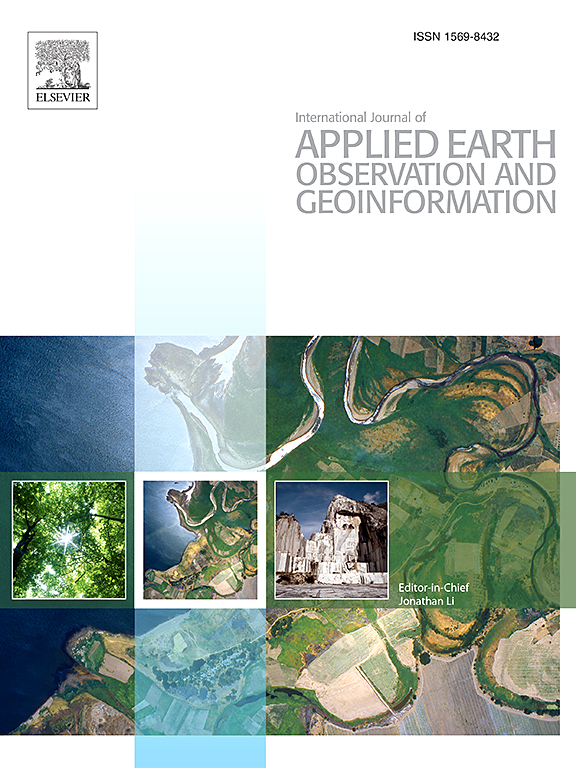A high-resolution remote sensing land use/land cover classification method based on multi-level features adaptation of segment anything model
IF 7.6
Q1 REMOTE SENSING
International journal of applied earth observation and geoinformation : ITC journal
Pub Date : 2025-06-13
DOI:10.1016/j.jag.2025.104659
引用次数: 0
Abstract
Land use/land cover (LULC) classification based on deep learning techniques is a significant research area for analyzing high-resolution remote sensing(HRRS) images. However, due to the limitation of available samples and model feature extraction capability, the current deep learning methods suffer from weak generalization ability for widespread and effective application across diverse HRRS scenarios. To address this problem, we propose an innovative network model named multi-level feature adaptation-segment anything Model (MLFA-SAM). The model employs a three-level fine-tuning strategy to adapt the SAM foundation model for remote sensing LULC classification. The proposed MLFA-SAM significantly enhances high-precision classification performance across diverse HRRS scenarios. Specifically, the domain distribution shift adaptation (DDSA) level is designed to adjust the input image modality for SAM and initially extract features and overcome the domain distribution shift between remote sensing images and the natural images used by the SAM. Then, we designed depthwise low-rank adaptation (DLRA) strategy to optimally fine-tune the frozen SAM parameters. Finally, we improved SAM’s mask decoder to generate high-quality multi-class masks required for LULC classification. Experimental results demonstrate that the MLFA-SAM model surpasses several existing state-of-the-art(SOTA) methods on the HRLC dataset and the ISPRS Potsdam dataset. Quantitative evaluations demonstrate that MLFA-SAM, with its concise yet efficient architecture, achieves 66.77% mIoU and 86.02% OA on the HRLC dataset. Notably, the integration of near-infrared (Nir) bands further enhances its performance to 68.43% mIoU and 87.91% OA. The generalization test on the LoveDA dataset, along with four test HRRS images exhibiting spatiotemporal and semantic scene differences, further demonstrate that MLFA-SAM possesses a stronger generalization ability compared to existing methods and shows greater potential for practical applications.
基于分段任意模型多层次特征自适应的高分辨率遥感土地利用/土地覆被分类方法
基于深度学习技术的土地利用/土地覆盖(LULC)分类是高分辨率遥感影像分析的重要研究领域。然而,由于可用样本和模型特征提取能力的限制,目前的深度学习方法泛化能力较弱,难以在不同的HRRS场景中广泛有效地应用。为了解决这个问题,我们提出了一种创新的网络模型,称为多层次特征自适应-分段任意模型(MLFA-SAM)。该模型采用三级微调策略,使SAM基础模型适应遥感LULC分类。提出的MLFA-SAM显著提高了不同HRRS场景下的高精度分类性能。具体而言,DDSA (domain distribution shift adaptation)级别是为了调整SAM的输入图像模式,初步提取特征,克服SAM所使用的遥感图像与自然图像之间的域分布偏移。然后,我们设计了深度低秩自适应(DLRA)策略,对冻结的SAM参数进行最优微调。最后,我们改进了SAM的掩码解码器,生成了用于LULC分类所需的高质量的多类掩码。实验结果表明,MLFA-SAM模型在HRLC数据集和ISPRS波茨坦数据集上优于现有的几种最先进(SOTA)方法。定量评价表明,MLFA-SAM结构简洁高效,在HRLC数据集上的mIoU和OA分别达到66.77%和86.02%。值得注意的是,近红外(Nir)波段的整合进一步提高了其性能,达到68.43% mIoU和87.91% OA。在LoveDA数据集上进行的泛化测试,以及4张具有时空和语义场景差异的测试HRRS图像,进一步证明了MLFA-SAM比现有方法具有更强的泛化能力,具有更大的实际应用潜力。
本文章由计算机程序翻译,如有差异,请以英文原文为准。
求助全文
约1分钟内获得全文
求助全文
来源期刊

International journal of applied earth observation and geoinformation : ITC journal
Global and Planetary Change, Management, Monitoring, Policy and Law, Earth-Surface Processes, Computers in Earth Sciences
CiteScore
12.00
自引率
0.00%
发文量
0
审稿时长
77 days
期刊介绍:
The International Journal of Applied Earth Observation and Geoinformation publishes original papers that utilize earth observation data for natural resource and environmental inventory and management. These data primarily originate from remote sensing platforms, including satellites and aircraft, supplemented by surface and subsurface measurements. Addressing natural resources such as forests, agricultural land, soils, and water, as well as environmental concerns like biodiversity, land degradation, and hazards, the journal explores conceptual and data-driven approaches. It covers geoinformation themes like capturing, databasing, visualization, interpretation, data quality, and spatial uncertainty.
 求助内容:
求助内容: 应助结果提醒方式:
应助结果提醒方式:


